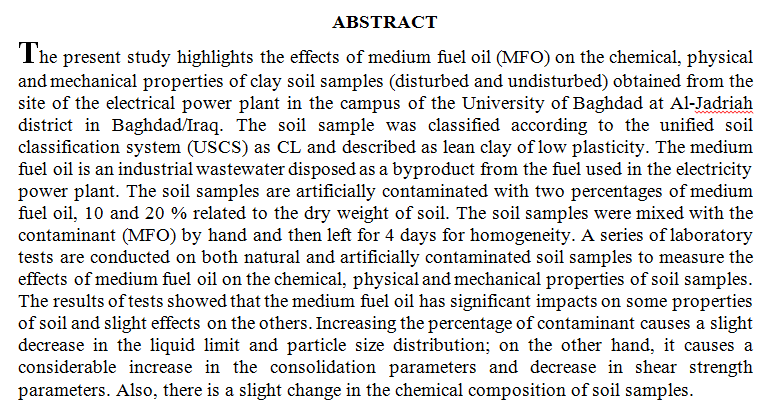
This research was aimed to study the efficiency of microfiltration membranes for the treatment of oily wastewater and the factors affecting the performance of the microfiltration membranes experimental work were includes operating the microfiltration process using polypropylene membrane (1 micron) and ceramic membrane (0.5 micron) constructed as candle; two methods of operation were examined: dead end and cross flow. The oil emulsion was prepared using two types of oils: vegetable oil and motor oil (classic oil 20W-50). The operating parameters studied are: feed oil concentration 50 – 800 mg/l, feed flow rate 10 – 40 l/h, and temperature 30 – 50 oC, for dead end and cross flow microfiltration.
It was found that water flux decrea
This paper aims to study the chemical degradation of Brilliant Green in water via photo-Fenton (H2O2/Fe2+/UV) and Fenton (H2O2/Fe2+) reaction. Fe- B nano particles are applied as incrustation in the inner wall surface of reactor. The data form X- Ray diffraction (XRD) analysis that Fe- B nanocomposite catalyst consist mainly of SiO2 (quartz) and Fe2O3 (hematite) crystallites. B.G dye degradation is estimated to discover the catalytic action of Fe- B synthesized surface in the presence of UVC light and hydrogen peroxide. B.G dye solution with 10 ppm primary concentration is reduced by 99.9% under the later parameter 2ml H2O2, pH= 7, temperature =25°C within 10 min. It is clear that pH of the solution affects the photo- catalytic degradation
... Show MoreMany carbonate reservoirs in the world show a tilted in originally oil-water contact (OOWC) which requires a special consideration in the selection of the capillary pressure curves and an understanding of reservoir fluids distribution while initializing the reservoir simulation models.
An analytical model for predicting the capillary pressure across the interface that separates two immiscible fluids was derived from reservoir pressure transient analysis. The model reflected the entire interaction between the reservoir-aquifer fluids and rock properties measured under downhole reservoir conditions.
This model retained the natural coupling of oil reservoirs with the aquifer zone and treated them as an explicit-region composite system
Background: The incorporation of rubber has not been entirely successful because it can have detrimental effects on the transverse Strength and hence the rigidity of the denture base. Materials and methods: Zirconium oxide nanoparticales were coated with a layer of trimethoxysilylpropylmethacrylate (TMSPM) before sonication in monomer (MMA) with the percentages 3% by weight then mixed with powder using conventional procedure.(100) samples were prepared and divided into five groups according to the test performed ,Each group consisted of 20 specimens and these were subdivided into 2 groupsGroup (A): control group (10 specimens of high impact acrylic resin without zirconium oxide) and Group (B):zirconium oxide group(10 specimens of high impac
... Show More (10)
(10)
In the present work a modification was made on three equations to represent the
experiment data which results for Iraqi petroleum and natural asphalt. The equations
have been developed for estimating the chemical composition and physical properties
of asphalt cement at different temperature and aging time. The standard deviations of
all equations were calculated.
The modified correlation related to the aging time and temperature with penetration
index and durability index of aged petroleum and natural asphalts were developed.
The first equation represents the relationship between the durability index with aging
time and temperature.
loge(DI)=a1+0.0123(2loge T
... Show MoreRecent research has examined the improvement of physical and dielectric properties of BaTiO3 ceramic material by small addition of excess TiO2 or BaCO3. The prepared samples sintered at different temperatures and varying soaking time. The results show that increasing the sintering temperature within 1350°C and soaking time of 10 hrs give better electrical and physical properties, which indicate the reaction is complete at higher temperature and period.
Preparation of superposed thin film (CdTe)1-xSex / ZnS) with concentration of (x= 0.1, 0.3, 0.5) at a temperature of substrate (Ts= 80 0C) by using Thermal Vacuum Evaporation System. The measurement of X-ray diffraction shows that the compounds CdTe, ZnS, (CdTe)1-xSex and (CdTe)1-xSex / ZnS have a polycrystalline structure, the C-V characteristic shows that the capacitance degrease by increasing the concentration (x) in reverse bias, while the I-V characteristic shows the current dark (Id) increase in forward and reverse bias by increasing (x) and the photocurrent (Iph) increase in reverse bias by increasing the concentration (x), the values of photocurrent are greater than from the values of the dark current for all concentrations
... Show More (6)
(6)
 (7)
(7)
High temperature superconductors materials with composition Bi1.6-xSbxPb0.4Sr2Ca2-yCdyCu3OZ (x = 0, 0.1, 0.2 and 0.3) and (y = 0.01 and 0.02), were prepared by using the chemical reaction in solid-state ways, and test influence of partial replacement of Bi and Ca with Sb and Cd respectively on the superconducting properties, all samples were sintered at the same temperature (850 oC) and for the same time (195 h). The structural analysis of the prepared samples was carried out using X-ray diffraction (XRD) measurements performed at room temperature, scanning electron microscope (SEM) and dc electrical resistivity was measured as a function of temperature. It was found that the sample prepared by partial substitution of Sb at ratio (x= 0.2
... Show More